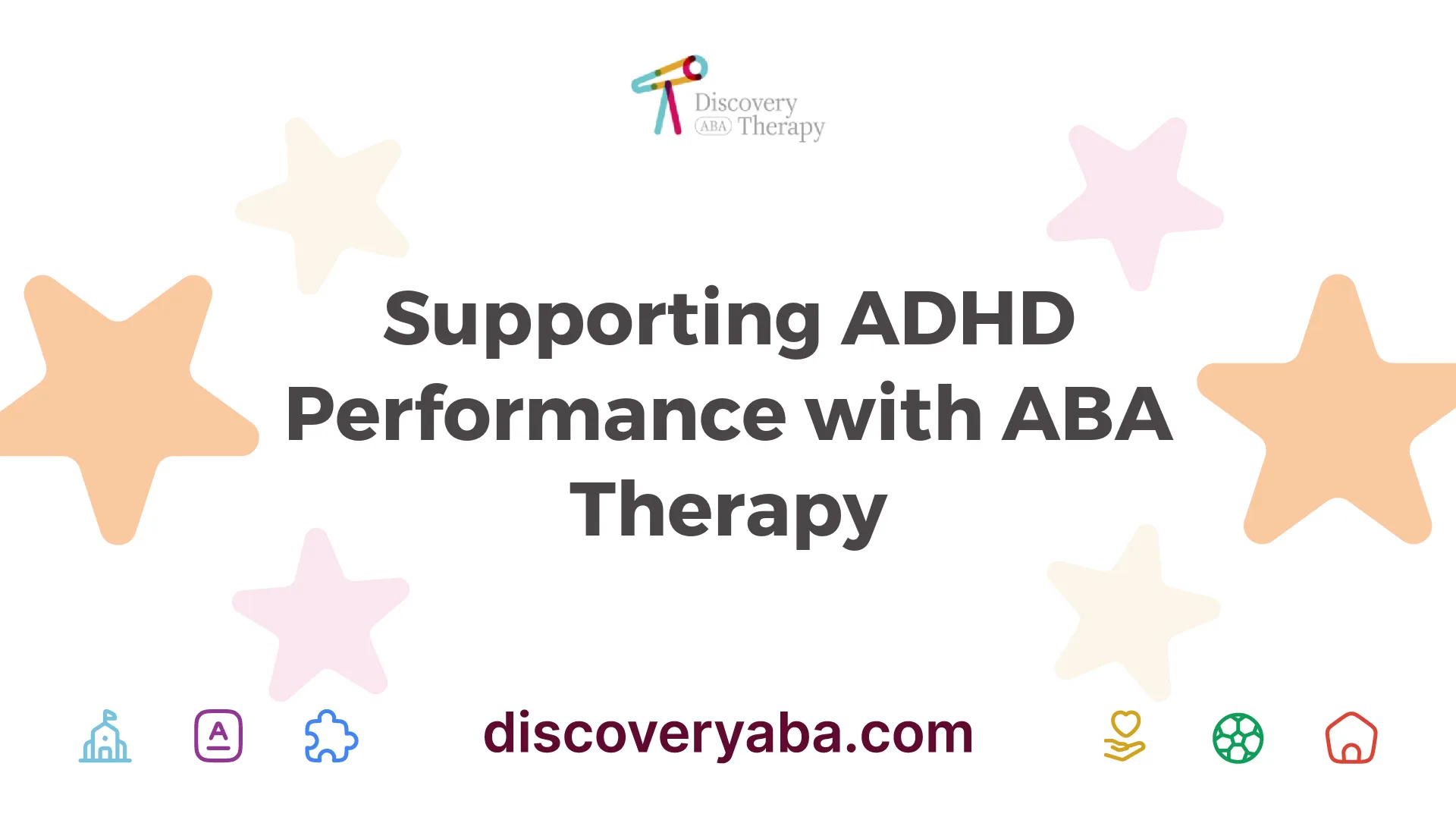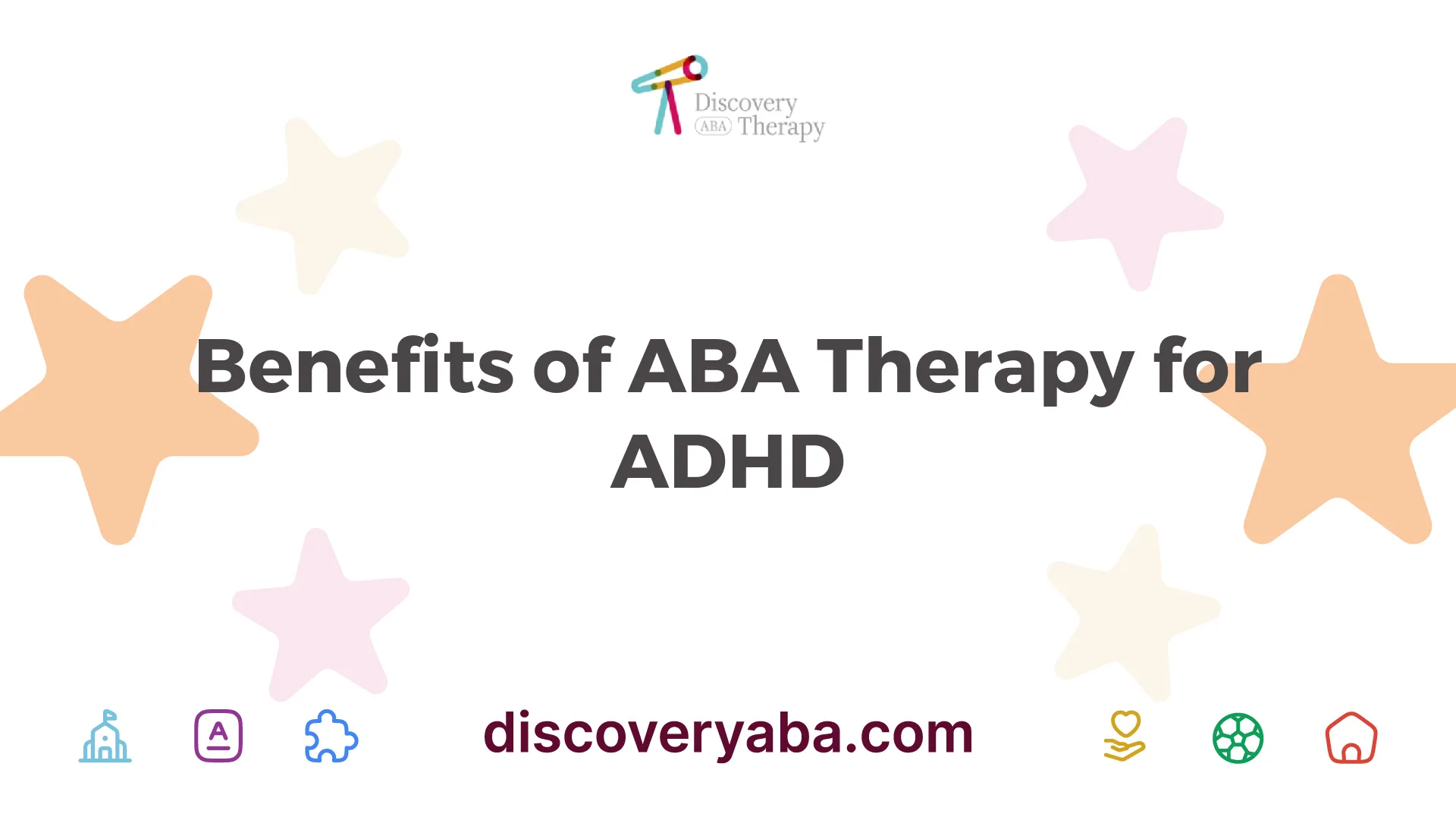Supporting ADHD Performance with ABA Therapy
Discover how supporting ADHD performance with ABA therapy can boost social skills and enhance daily functioning.

Understanding ABA Therapy for ADHD
Effectiveness of ABA Therapy
ABA therapy, endorsed by the Centers for Disease Control and Prevention (CDC) for treating ADHD, focuses on helping children with this condition learn new skills while reducing problem behaviors. Numerous studies (ABTABA) have shown that ABA therapy can be effective in managing ADHD, demonstrating significant improvements in social skills, adaptive behaviors, and reductions in issues such as hyperactivity, inattention, and aggression.

The effectiveness of ABA therapy can be measured through various assessments, indicating the degree of change in behavior and skills. Below is a table summarizing the typical improvements observed in children undergoing ABA therapy for ADHD:
Area of ImprovementDescriptionTypical Percentage of ImprovementSocial SkillsEnhancement in interaction skills40-60%Adaptive SkillsSkills for daily living30-50%Problem BehaviorsReduction in hyperactivity and aggression50-80%
Principles of ABA Therapy
ABA therapy relies on a set of core principles that guide its application in behavioral interventions. These principles include positive reinforcement, structured routines, and the use of visual aids, which help children with ADHD improve their focus, organization, and time management skills while simultaneously reducing challenging behaviors.
Key principles of ABA therapy for ADHD include:
These techniques cater to the unique needs of children with ADHD, making ABA therapy a flexible and customizable intervention approach. For further insights on structured approaches in ABA, you may find our evidence-based ABA therapy practices for ADHD useful. Additionally, discovering the long-term benefits of ABA therapy for ADHD can provide a broader understanding of its relevance in ongoing ADHD management.

Benefits of ABA Therapy for ADHD
ABA therapy has been recognized for its effectiveness in supporting individual performance with ADHD. It helps in various aspects of development, notably in improving social skills and enhancing executive functions.
Improving Social Skills
ABA therapy plays a crucial role in developing social skills for individuals with ADHD. It incorporates structured routines and positive reinforcement tailored to address the unique challenges faced by these individuals. By utilizing engaging activities and targeted social scenarios, ABA therapy fosters interaction and communication skills among peers.
Research highlights that children benefiting from ABA therapy show improved abilities to establish and maintain friendships. They learn appropriate social cues, which can significantly reduce the incidence of challenging behaviors ABA Therapy for ADHD and Social Skills.
Social Skills AreaImprovement (%)Communication70Emotional Regulation65Peer Interaction75
The statistics demonstrate that a significant percentage of children show marked improvement in communication abilities, emotional regulation, and peer interaction through ABA therapy. These advancements often lead to better relationships and a more satisfying social life.
Enhancing Executive Functions
Executive functions such as self-control, organization, and time management are often areas of difficulty for individuals with ADHD. ABA therapy specifically targets these skills through tailored interventions. The principles of ABA emphasize structured routines along with visual aids to aid children in managing their tasks more effectively.
A study conducted at the Hospital for Sick Children in Toronto indicated that ABA therapy notably enhances executive functions, helping improve self-control and mindfulness in children with ADHD [1].
Executive Function AreaImprovement (%)Self-Control60Organization55Time Management50
These figures illustrate how a focus on enhancing executive functions leads to substantial improvements in areas critical for daily functioning and academic performance. The flexibility and tailored nature of ABA therapy make it a valuable strategy in supporting ADHD performance. For more insights on the long-term advantages of this approach, explore our article on long-term benefits of ABA therapy for ADHD.
Tailored Approach of ABA Therapy
Customized Interventions
ABA therapy utilizes tailored approaches to address the specific needs of children with ADHD. This flexibility allows therapists to create interventions that enhance behavioral and social skills, making it a valuable resource for families. The process begins with behavioral assessments and ongoing observation to understand each child's unique challenges and strengths. This information helps therapists develop personalized strategies that target specific behaviors associated with ADHD.
These customized interventions may include:
Intervention TypeDescriptionBehavioral AssessmentsEvaluates the child’s behaviors and identifies areas of need.Skill DevelopmentTeaches new skills tailored to the child's daily life.Positive ReinforcementEncourages desired behaviors through rewards.Individualized StrategiesAddresses specific behavioral challenges, such as impulsivity or inattention.
Parents can also apply some of these strategies at home. By using positive reinforcement and other ABA techniques, they will help their children develop effective behaviors and life skills.
Flexibility in Treatment Plans
The flexibility of ABA therapy treatment plans is essential in managing ADHD effectively. As children's needs can change over time, ABA allows adjustments to be made to therapy approaches based on ongoing assessment results. This responsiveness ensures that the interventions remain relevant and effective.
Different elements that can be modified within ABA plans include:
Plan ComponentPossible AdjustmentsGoalsChanging focus areas based on progress or emerging challenges.StrategiesIntroducing new techniques or methods as needed.Frequency of SessionsAltering how often therapy sessions occur to match the child's current requirements.
This adaptability not only supports continuous improvement but also reinforces the effectiveness of ABA therapy in addressing ADHD-related challenges. For more detailed insights into the long-term benefits of ABA therapy, see our article on long-term benefits of aba therapy for adhd.
Implementing ABA Strategies at Home
Implementing ABA therapy strategies at home can significantly enhance the effectiveness of treatment for ADHD. Parents and caregivers can adopt various techniques to support children's behavior and skill development. Two key areas to focus on are positive reinforcement techniques and behavior management strategies.
Positive Reinforcement Techniques
Positive reinforcement is a fundamental concept in ABA therapy. It involves providing rewards or incentives after desired behaviors, increasing the likelihood that those behaviors will be repeated in the future [3]. This method is particularly effective for children with ADHD, as it encourages good behavior and motivation.
BehaviorPositive ReinforcerCompleting homeworkExtra playtimeFollowing instructionsStickers or tokensSharing with peersPraise and encouragement
By clearly identifying desired behaviors and corresponding rewards, caregivers can create a structured environment that promotes positive behavior change. Additionally, consistent application of positive reinforcement helps children understand the direct connection between their actions and the rewards they receive.
Behavior Management Strategies
Behavior management strategies are vital in reducing challenging behaviors often associated with ADHD. One effective approach is operant extinction, which involves discontinuing reinforcement for previously rewarded behaviors. This can lead to a decrease in the frequency of those behaviors over time [3].
Other effective strategies include:
For comprehensive information on these topics, parents can reference our articles on evidence-based ABA therapy practices for ADHD and building attention skills with ABA therapy for ADHD. These strategies not only improve day-to-day functioning but also empower children with ADHD to navigate their challenges more effectively, leading to long-term benefits. Visit our section on long-term benefits of ABA therapy for ADHD for further insights.
Role of ABA Therapy in ADHD Management
ABA therapy serves a significant function in managing ADHD, particularly through skill development and enhancing communication abilities. These areas are crucial for individuals with ADHD to improve overall functioning in daily life.
Skill Development
ABA therapy focuses on developing essential life skills relevant to ADHD management. By implementing structured routines and visual aids, ABA therapy assists children in enhancing their focus, organization, and time management skills while reducing challenging behaviors [1]. This comprehensive approach supports the holistic development of children, equipping them with the necessary skills for academics and self-care.
The following table illustrates the key skills targeted through ABA therapy for individuals with ADHD:
Skill AreaDescriptionOrganizationTechniques to help manage tasks and keep environments tidyFocusStrategies to improve concentration on tasksTime ManagementMethods to understand and allocate time effectivelySocial InteractionSkills for engaging positively with peersSelf-CareBasics of personal hygiene and daily routines
ABAB therapy also emphasizes positive reinforcement to encourage the adoption of new skills, which can significantly contribute to the long-term development of these abilities in children [2].
Communication Enhancement
Effective communication is a cornerstone of social interaction and academic success for children with ADHD. ABA therapy aims to improve communication skills through targeted interventions. The therapy helps therapists assess behaviors and motivations behind specific communication patterns, allowing for tailored interventions that boost social skills.
Studies indicate that ABA therapy enhances communication by focusing on:
By fostering these communication skills, children with ADHD can better navigate social situations, minimizing misunderstandings and promoting healthier interactions.
The integration of ABA therapy with other treatment options, like medication, can lead to optimal results for children facing ADHD challenges. For more information on methodologies, refer to our articles on evidence-based aba therapy practices for adhd and long-term benefits of aba therapy for adhd.
ABA Therapy vs. Other Treatment Options
In considering the best ways to manage ADHD, it's essential to compare ABA therapy with other available treatments. Combining various approaches often results in improved outcomes for individuals with ADHD.
Combined Approach Benefits
Research indicates that a combination of medication and ABA therapy yields the best outcomes for children with ADHD. Integrating behavioral therapy with stimulant medications helps children manage everyday challenges effectively. Such combinations have been shown to improve skills and reduce impulsivity, potentially allowing for lower doses of medication.
Treatment TypeBenefitsMedicationFast-acting relief of symptomsABA TherapySkill development, behavior modification, social skills improvementCombinedEnhanced effectiveness, lower medication doses
Medication and Behavioral Therapy
The American Academy of Pediatrics recommends utilizing therapy as a primary treatment for ADHD, particularly for children under six years old. Behavior modification strategies and ABA techniques can help therapists and parents pinpoint challenging areas and tailor interventions accordingly.
While medication can provide immediate symptom relief, ABA therapy can address underlying behavioral issues. It emphasizes developing social skills, enhancing executive function, and improving overall functioning in daily life.
ABA therapy with a Board-Certified Behavior Analyst (BCBA) can be a vital component of a comprehensive treatment plan for children with ADHD. Effective ABA techniques, such as Differential Reinforcement of Alternative Behaviors (DRA) and Task Analysis, can be personalized to meet the specific needs of children, promoting positive behavior changes.
Balancing medication and behavior therapy can promote a more holistic approach to supporting ADHD performance with ABA therapy. For more information on interventions and their effectiveness, check out our articles on the science of ABA therapy for ADHD and long-term benefits of ABA therapy for ADHD.
References
[2]:
[3]:
[4]:
[5]:
[6]:
Does Your Child Have An Autism Diagnosis?
Learn More About How ABA Therapy Can Help
Find More Articles
Contact us
North Carolina, Nevada, Utah, Virginia
New Hampshire, Maine
Arizona, Colorado, Georgia, New Mexico, Oklahoma, Texas
.avif)




































































































